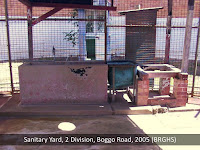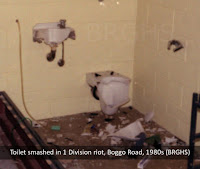The Toilet Tubs
The tubs were originally made decades ago in the old tin workshop at the prison. They were 26cm in diameter and 27cm high. The cell numbers were painted on top of the lids, and every morning they would be carried to 3A, the special ‘sanitary yard’ behind F Wing, for emptying and washing. An experienced worker could carry six tubs in each hand. As you can see in the photo gallery below, the sanitary yard in No. 2 Division is still largely intact. It contains a concrete trough for emptying the tubs out, a water boiler, and several shower heads.
Gallery: Sanitary Yards at Boggo Road (click to enlarge images)
"It should be noted in particular that the shit tub yards of 2 Division was a popular place to bathe, as prisoners in this area would block the sewer outlet in the bath sized disposal point and fill it with water for bathing; this was a sight to behold."Of course there was always more than one use for a metal tub in a prison. The (clean) tubs could be used to hide and transport contraband, or provide endless target practice for bored inmates as they spat into it from their beds. During prisoner protests the lids could be banged in noisy solidarity on cell doors. There were also times when the tubs were used in fights between prisoners, and some of the less-trusted inmates were given rubber tubs for fear that they might use a steel-hardened can as a weapon. Some particularly unruly inmates were known to throw the contents of their tub over unsuspecting officers when their cells were being opened in the mornings.
The toilet tub system was in place until No.2 Division closed in 1989, although the newer No.1 Division cellblocks that were built during the 1970s had toilets in the cells. A true luxury for the inmates in No.1 Division! Still, as the 1980s photo in the photo gallery shows, this luxury was not always appreciated and the toilets were among the first things to go when prisoners smashed up their cells during riots.
After years of being used in their particular way, the tubs were then used as ash trays and waste bins by some unthinking visitors on the 'ghost tour' cellblock sleepovers when the gaol opened as a museum. This kind of disrespectful cell damage led to the sleepovers being stopped. The tubs later became part of the Boggo Road Gaol Museum collection.
Back to Prison Life
Back to the History Vault




















Leave a Comment